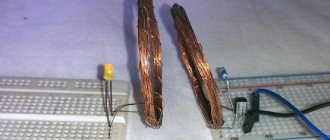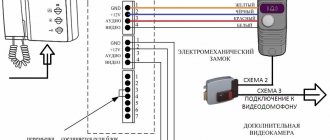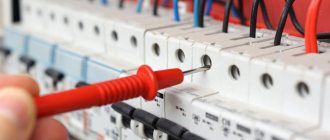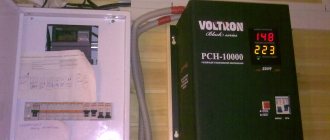How to independently check current leakage using a household multimeter or an indicator screwdriver
Professional electricians quite often encounter current leakage when inspecting electrical wiring, especially old wiring, electrical appliances of poor quality and other electrical equipment. The problem of leakage current is also quite common in the operation of cars and causes rapid discharge of the battery. This article will discuss actions to identify electricity leaks in relation to a 220V home network, but there are no fundamental differences between it and a car electrical network.
The reasons for current leakage are quite commonplace; over time, the protective insulation of the wire wears out and its characteristics change. If the wiring is used incorrectly, kinks, cracks, and abrasions appear on the wire insulation. The main task of insulating wiring and conductive elements is to protect people from electric shock and prevent leakage of electricity.
Even new electrical appliances and wiring have small current leaks. Almost any insulation is not ideal, especially for cheap cables in the low price category. Cheap electrical wiring, as a rule, has microcracks from the factory, it is less resistant to temperature and humidity changes, and small thickness defects are often found. Improper operation, overheating of the wire at loads exceeding the design ones - all this damages the insulation and leads to current leaks.
Current leakage can be determined by the following characteristic signs: touching the body of an electrical appliance, a wall, or a pipeline causes a slight tingling sensation in the fingertips. But be careful - a leakage value not exceeding 10 mA is considered safe, but a leakage current of more than 30 mA is deadly.
If you suspect a current leak, you must immediately turn off the power to the room and call professionals. A car with significant leaks is also unsafe to operate. The second sign of current leakage is increased consumption disproportionate to use and, as a result, large electricity bills or discharge of the battery in the car.
What devices can detect electricity leaks?
Electrical laboratory specialists use a professional device for measuring insulation resistance - a megohmmeter. Such devices are quite expensive and are not used in everyday life.
In many homes or garages, you can find a household multimeter and an indicator screwdriver, and with them you can independently locate the location of a current leak or an electrical appliance with defective insulation.
In order to check the insulation resistance of an electrical appliance using a “household multimeter”, it is necessary to completely disconnect the device being tested from the power supply. On the multimeter, set the regulator to the 20 MΩ position. Touch the pin of the plug with one probe, and the metal part of the electrical appliance with the other, it is better to sequentially in several places. If the number “1” is displayed on the display, then there is no leakage current, the insulation is working properly, indicators on the screen below one indicate leakage currents and the lower the indicator, the greater the leakage current.
If you do not have a multimeter, then you can detect a leak with a regular, even the cheapest indicator screwdriver. Modern indicators are sensitive even to small currents. The algorithm of actions is even simpler; you need to plug in the device and touch the tip of the screwdriver to the metal parts of the device, pipeline or walls in several places. It is better to pre-shade the room; if there is a leakage current, the indicator will light up with varying degrees of intensity.
How to find a leak in electrical wiring or cable
It is impossible to find an insulation defect in hidden wiring without special equipment. In this case, it is necessary to call specialists from an electrical engineering laboratory. When open, you can visually carefully inspect the wire for damage to the insulation, especially in places where the cable comes into contact with walls, risers, and metal parts.
What is the danger of current leakage
If you use your car every day but don't experience any problems starting the engine, this does not mean there is no leak. If skipping one or two days already causes difficulties when starting the power unit, we can conclude that there is a leak, and although it is not critical, there is no need to delay solving the problem. We have already noted that the reason may be exposed wires, which threatens a short circuit and failure of expensive electronics (for example, an ECU). In the worst case, the short circuit causes the car to catch fire, and if it happens somewhere in a hidden place, the chances of saving the car quickly disappear.
If you can’t start diagnosing yourself or visiting a service station in the near future, a few simple recommendations will allow you to avoid completely discharging the battery:
- After the car is parked, remove the terminals from the battery. Yes, this is an additional burden, but believe me, it is much easier than searching for ways to start the engine with a dead battery;
- In winter, this measure may not save you, especially in severe frosts, so it is better not to just remove the terminals, but also take the battery to a heated room overnight. Such a precaution may seem unnecessary, but if there is a current leak and the battery is not new, it is better to be safe than to frantically look for ways to revive a dead battery on a frosty morning;
- Be smart: buy starter leads and carry them with you at all times. If it happens that the battery is still discharged, it will be easier for you to find a donor for lighting.
These simple tips will allow you to avoid getting into unpleasant situations until the on-board network is repaired to eliminate current leakage.
Finding the cause of current leakage
There are several reasons for current leakage in a car. These may be regular problems with the factory equipment that was installed during the construction of the car. These include:
- wiring;
- audio system;
- generator;
- alarm;
- starter.
But standard leaks appear less frequently and mainly due to the high mileage of the vehicle.
Non-standard devices include those devices that the driver additionally installed on the car. For example, this could be a video recorder, a navigator, an alarm system and a non-factory radio, as well as cameras and radar detectors.
Therefore, when the test readings are above 80 mA, it is important to find a current leak. First of all, you need to check the following points:
- Determine which battery is worth. If it is old, then current leakage is normal for a worn-out device.
- Check that the headlights, dimensions and car radio are turned off.
- Look at the wiring insulation, it may be the cause.
- Possible heavy dust on the contact terminal blocks or on the sockets to which devices in the car are connected. Due to the large layer of dust, they could oxidize.
- Negligence in installing additional devices, which led to a short circuit.
- Metal fasteners damaged the wiring.
- Melted wires that are close to the motor.
If all these points have been checked and no problems are found, then the problem may be the formation of salt deposits on the circuit with a thick starter wire as a result of water accumulation. This problem is also possible with the generator wiring. The battery itself also gets dirty on top.
On a note!
If there are problems with the insulating layer of the electrical wiring, spontaneous combustion is possible!
If the problem cannot be detected, it is recommended to conduct a full diagnosis of the generator. To do this, you need to measure the voltage on the battery. This is done as follows:
- turn off the engine;
- two terminals from the battery are removed;
- connect the multimeter: the black probe of the device is negative, and the red probe is positive;
- with a charged battery, the value should be 12.5–12.9 V.
After the procedure, the terminals are returned to their place and the engine is turned on. After this, we turn on the heated glass, climate control and side lights. This is necessary to load the generator. Reconnect the multimeter to the battery. The reading should be between 13 and 13.3 V. A maximum reading of 14.3 V is possible.
If the indicator does not exceed 13.8 V, then most likely the cause of the leak is in the generator. Then it’s best to go to a service center and do a full diagnosis. If the indicators correspond to the required range, then the cause of the leak is in the network itself.
Causes of battery current leakage
The battery is considered one of the main components of a car's operation. It must be charged, thereby ensuring the operation of the engine and other devices. Often the cause of current leakage is the owner's forgetfulness. Many people leave their car overnight with the equipment turned on or put off buying a new battery for a long time. In addition, current may leak due to irregularities in the wiring. Thus, the causes of leakage are:
- Long battery life;
- Headlights, lights, radio not turned off;
- Destruction of the insulating layer of wires under the influence of unfavorable climatic and road factors;
- Oxidation of main components or accumulation of a layer of dirt on them (sockets for connecting devices, contacts of terminal blocks);
- Short circuit in the wiring of additionally installed equipment due to carelessness in laying the wires;
- Damage to wires by metal fasteners;
- Melting of some sections of wiring located near the engine.
Having ruled out the possibility that the driver does not forget to turn off the headlights and electronics, you should look for a current leak in another place.
Current testing
To begin with, we determine what kind of current flows in the circuit - alternating or direct. The choice of the socket for the black probe, from the “10 A” or “VΩmA” options, is made after specifying the approximate parameters in Amperes. The procedure is largely identical to the one discussed above. If, after connecting to the connector with the maximum current value, the display shows a significantly lower value, place the plug in another socket. When re-displaying smaller parameters, we stop at the range with a lower amperage.
It is important to remember that the connection of the device in the circuit in this case is also carried out exclusively in parallel
ABS sensor
It is checked by two parameters: voltage and resistance.
To start measuring, select the appropriate mode on the multimeter. If you want to know the resistance value, for most the norm is 1.2-1.8 kOhm. Connect the device to the sensor and start taking measurements. At the same time, shake the wires going to the element. If the numbers on the screen change and become higher or lower than normal, there is a problem with the sensor.
Measuring voltage is a little more difficult - this can only be done with a jack or in a car service on a stand. You need to spin the car wheel to 40-50 rpm and monitor the multimeter readings. On any machine it should output 2 volts.
Voltage measurements
For a network with alternating voltage, the switch arrow is set to ACV. Probes are connected to the COM and “VΩmA” connectors. If you are unsure of the approximate range of the voltage being tested, select the maximum value. When a value less than the set value appears on the display, the switch is switched to a lower voltage level. Using the selection method, you can quickly determine the approximate value of the desired value. For a constant voltage network, this process is carried out in a similar way. Most often, in the second option, the 20 V mark is selected. An example would be repair work on the electrical equipment of a car.
It is safe to say that such an event does not cause any major difficulties. You just need to adhere to basic safety measures - avoid touching the bare areas of the probes with your hands.
Self-diagnosis with a multimeter
Diagnostics is carried out using a conventional multimeter (tester). Current measurements are carried out in a mass discontinuity or in a “positive” section discontinuity. The mass discontinuity detection scheme is considered safe. To do this you need to do the following:
- The multimeter settings correspond to measuring current readings in amperes (10-20 A);
- Disconnect the negative terminal from the battery;
- Connect one wire of the tester to the battery terminal;
- The other wire of the tester should be on the removed wire.
The polarity may not be observed for the electronic tester. Before starting measurements, turn off the ignition and remove the key.
Detecting a leak in the positive gap involves the following scheme:
- Set the amperes on the device;
- Disconnect “+” from the battery;
- Connect the negative connector of the tester to the disconnected battery terminal;
- Connect the positive connector of the tester to the “-” battery.
If the steps are completed correctly, a current value will appear on the tester screen. Exceeding the norm (15–80 mA) by the found current value indicates a leak. As a result, you need to look for the problematic circuit.
How does the battery drain?
Accelerated battery discharge occurs when the specified value is exceeded several times. If the norm is exceeded slightly (up to 0.1–0.5 A), the car owner will not notice the problem and will calmly continue to operate the car, although the service life of the power source will begin to noticeably decrease.
When the consumption of any electrical appliance causes the current in the circuit to increase from 1 to 10 A, the battery will begin to discharge very quickly - literally overnight. Why does automotive equipment “pull” electricity from the battery at rest:
- In the vast majority of cases (about 90%), the cause of accelerated discharge is unqualified intervention in the electrical circuit of the machine. This includes the installation and incorrect connection of non-standard devices - amplifiers, subwoofers, power windows, fog lights and additional heaters.
- On cars with high mileage (over 200 thousand km), problems with power equipment - the generator or starter - often occur. As a result, the windings of these units become energy consumers.
- Sticking of the contacts of one or more relays that include power circuits, for example, a glass or seat heater.
If you are faced with a situation where you need to recharge a perfectly good power source every day, you need to measure the battery leakage current and compare the readings with the norm. If exceeded, try to find the source of the problem using the methods described below.
Important note. A short circuit in electrical wiring to car body parts due to insulation failure is not considered a leak.
Such a malfunction manifests itself differently - the smell of burnt plastic is heard, smoke and sparks are visible, then the conductor burns out or causes a fire. In such a short period of time, the battery does not have time to discharge to zero.
How to check current leakage in a car with a multimeter
When the first signs of such a malfunction appear, it is necessary to check the current leakage in the car using a device.
Check sequence:
1. Before performing work, you need to find a diagram of the location of the car's fuses. This can be done by downloading the car's operating manual and asking the appropriate request in a search engine. In some cars, the fuse code is located on the fuse box cover. You need to find all the places where there are fuses in the car.
2. The positive terminal of the battery is removed. The ignition and all electrical equipment of the car must be turned off. Some experts recommend monitoring via the negative terminal. There are no fundamental differences, the circuit is still the same. When monitoring using the positive terminal, it is easier to search for a specific leak location.
3. The multimeter switches to the 10 Ampere DC measurement mode, the probes are installed in the appropriate connectors. It is better to put crocodile tips on the probes.
4. Next, the positive (red) probe is carefully secured to the positive terminal of the battery, the negative one - to the removed terminal going to the vehicle equipment. The location of this connection must be protected from accidental contact with the car body (you can simply temporarily insulate it with a rag) so that there is no short circuit.
5. The digital display of the multimeter will indicate the leakage current. If its value is less than 0.2 Ampere, no further control can be performed. If the current is more than 0.5 Ampere, that is, the critical value, it is necessary to proceed to further operations.
In the case when its value is in the range from 0.2 to 0.5 Ampere, the decision on the advisability of further actions is made independently. If the current exceeds the upper measurement limit (as shown in the following photo), you should stop measuring immediately and call a specialist.
6. If the leakage current in the car is greater than the critical value, begin to search for the specific cause and its source.
An assistant is needed for this. He will sequentially remove and insert fuses into their original places. At this time, the “operator” of the multimeter must monitor changes in the device readings.
If, with the fuse removed, the readings do not change significantly (by more than 5%), it means that practically no leakage current flows through this fuse.
It is more correct to start turning off - turning on with powerful fuses designed for high currents. This can speed up the search process. Usually along a chain of large rated fuses there are several smaller fuses.
If, for example, when dismantling the fuse responsible for the body control unit, the leakage current has decreased significantly, it is necessary to move on to monitoring small fuses responsible for lighting equipment, wipers, washer and other elements of body equipment.
Video - finding a current leak in a car:
It is best to go through all the fuses using this method. Car alarm fuses are usually not installed in standard places; they can “hang” next to the main alarm unit.
Some auto electricians use a sophisticated testing method. It does not require an assistant.
7. Complicated method. In this case, the positive terminal of the battery is connected back. The fuses are pulled out sequentially. The multimeter probes are installed in the connectors of the removed fuse, monitoring the current in a specific circuit. This method is more labor-intensive, but accurate.
8. Having deciphered all the circuits through which current flows from the fuse layout diagram, proceed to establish the specific cause of the leak in these circuits. To do this, you need experience working with car electrical circuits. The most common reasons:
- wiring short;
- relay sticking;
- failure of electronic components.
9. To temporarily eliminate the problem of current leakage, you can not replace the fuse through which the leakage occurs. For example, if the cause of the leak is a malfunction of the car radio, you can turn off the corresponding fuse while parked.
Leakage current in a car: what you need to know
If we consider leakage current, we must take into account that this phenomenon is present to a greater or lesser extent on many cars. This depends both on the design features and on the installation features of various additional equipment.
For example, on many VAZ models the leakage currents are initially large. The fact is that the power system on some models of domestic cars is not fully thought out; a large number of consumers do not turn off after the driver removes the key from the ignition switch.
As a result, consumers use up charge even when the car is closed. Of course, in new models (for example, Lada Vesta), this problem has been eliminated, but the presence of additional devices and non-standard equipment can still lead to such solutions draining the battery. The main reason is that if you install certain devices incorrectly, there is a high risk of battery consumption even after the device is turned off. Let's figure it out.
- First of all, the causes of current leakage can be associated with both standard and non-standard equipment. In other words, the following may fail or malfunction: a generator, a starter, an audio system, a standard alarm system, etc. Often problems arise with wiring.
As a rule, problems with the starter (for example, a starter with a stuck bearing) are expressed not only in the fact that the starter turns poorly. In such a situation, this device will greatly discharge the battery every time the engine is started.
If the trips are short, then it will simply not be possible to restore the charge from the generator. Of course, after several starts of the engine with a faulty starter, the battery will be discharged.
However, in practice, such problems more often arise on old cars or cars with high mileage, the units and components of which are quite worn out.
- As for more “fresh” or fully operational cars, in this case there are usually current leaks due to the installation of third-party equipment. For example, the battery can be severely discharged by an alarm system or security system, radio tape recorders, amplifiers, subwoofers, video recorders, GPS navigators, various heating systems, connected chargers for all kinds of devices, etc.
It is important to understand that the problem cannot be ignored. A deep discharge of the battery will damage even a new battery! The fact is that acid batteries with an electrolyte of sulfuric acid and distilled water are most often used. So, during a discharge, sulfuric acid in the form of salts settles on the plates; the salts turn into crystals and do not dissolve.
The result is a drop in battery capacity several times, a decrease in starting current and loss of performance. It turns out that the battery should not be allowed to be deeply discharged, which cannot be achieved if there is a current leak.
What current leakage is normal?
A car has a large number of different electrical consumers (the wiring itself, relays, various controllers, etc.). Also, the “minus” of the battery is screwed to the body (ground). The body itself has static energy, which also leads to leakage.
One way or another, there will be a current leak even on a fully functional car. The main thing is that it fits within the acceptable values. Please note that the indicators for different cars will differ (depending on the size of the car, its equipment, etc.) A small current leakage from 15 to 75 or even 80 mA can be considered the norm. Usually, on average, the leakage is about 40 milliamps.
If the leakage current is several hundred milliamps or even amperes, then it is necessary to carry out diagnostics, since in this case such a leakage current clearly indicates problems.
How does it proceed
- Option one. The housing or frame of an electrical installation (refrigerator, system unit, washing machine, etc.) touches a metal conductor in contact with the ground. This could be a heating radiator, a damp concrete floor in an apartment, or another electrical installation connected to ground. At the point of contact, the circuit closes and the same leakage current occurs. What is the danger? Local heating of the contact point may cause a fire. If the contact is reliable, the current will increase to the threshold of the protection device (input circuit breaker on the power panel). With a weak touch, sparking and the same local heating will be observed. Most often, this leads to melting and further damage to the supply wires. In addition, this phenomenon provokes electromagnetic interference.
- Option two. The electrical installation housing does not have contact with grounded objects and is not itself grounded. When a person touches the external panels, a load occurs (the human body is a conductor), and an electric current flows through the body. Since the resistance in this case is high, the current strength is insufficient to trip the circuit breakers. But harm to health, even death, can be caused. It is unacceptable to rely on the user to wear shoes with rubber soles. It’s the same as thinking that a linoleum-covered floor protects you from electric shock. Moreover, when the washing machine is operating, the owner’s hands are most often wet, which reduces the resistance of the skin. And if in the first case a properly selected circuit breaker is sufficient, the second option requires more advanced measures. For example, the inclusion of an RCD in the power circuit, which reacts to a small leakage current rating, provokes the operation of a circuit breaker.
Important: Even if you are confident that electrical installations and current-carrying lines are in good condition, periodic checking of current leakage is mandatory in each room. How can you determine whether there is a problem or not? To measure the leakage current, they usually call a team of master electricians who search for problematic installations using the device
At industrial facilities, this procedure is mandatory, as well as when commissioning housing stock. At large enterprises in big cities, such as Moscow, there are even staff departments of specialists on this issue
How can you determine whether there is a problem or not? To measure the leakage current, they usually call a team of master electricians who search for problematic installations using the device. At industrial facilities, this procedure is mandatory, as well as when commissioning housing stock. At large enterprises in big cities, such as Moscow, there are even full-time departments of specialists on this issue.
How can you independently check the leakage current in an apartment or residential building? The sensation of tingling electric current when you touch the body of the washing machine with a wet hand is a dubious and dangerous diagnosis.
High leakage currents
The power supply discharge accelerates if the leakage current reaches significant levels. Recharging the battery is a temporary measure.
If vehicles are equipped with lead-acid batteries, then frequent discharges provoke the deposition of salt compounds on the terminals and plates. The area suitable for work is reduced. The characteristics and parameters of the battery deteriorate.
As soon as the process of crystallization of deposited salts starts, the device completely fails. It is impossible to resuscitate him. Therefore, you will need to select and purchase a new power source.
How to find an energy consumer?
Further search for current leakage in the car is carried out using the fuse box (usually installed under the hood near the windshield). The procedure is as follows:
- Leave the ammeter connected to the battery terminals and remove the fuse box cover.
- Alternately pulling out the fuses from their sockets, monitor the readings on the multimeter display. If the manipulation does not produce results and the current value remains the same, insert the element back into the socket and move on to the next one.
- When you notice a drop in current to normal, find out which electrical appliances are “hanging” on the circuit of the pulled fuse. Look for the “culprit” using the method of elimination, checking each consumer separately.
Example: a high-consumption circuit powers 3 pieces of equipment - a cigarette lighter, a rear window defroster and a courtesy lamp.
It is not difficult to deal with the cigarette lighter and the light bulb - you need to turn off these devices and measure the current at the relay contacts that close the heater circuit. If the readings are higher than normal, disconnect the heating element connector and try replacing the relay. Several consumers are powered directly from the battery, bypassing the fuse box. This includes the electronic engine control unit, starter and generator. If manipulations with fuse links do not bring results and the display readings have not changed, proceed to checking the electric generator:
- Disconnect the positive battery terminal.
- Unscrew the power wire from the generator and wrap the exposed end with any dielectric (you can use a rag) to avoid a short circuit.
- Connect a multimeter to the battery open circuit and check the current value. If the diode bridge in the generator fails, consumption will drop to normal.
Typically, a broken alternator diode causes a large current draw, measured in amperes. The loaded winding acts as an electromagnet, which can be easily checked using a metal key attached to the unit pulley. If the key is pulled, the electric generator is probably faulty and is wasting battery power.
In a similar way, you can measure current leakage in other directly connected circuits. Look at the electrical diagram of the car and disconnect the wires one by one, bypassing the fuse box. If for various reasons the multimeter is missing, try to solve the problem in the following ways:
- carefully inspect the inside of the car for a burning light in the glove compartment or trunk;
- try with your hand the glass with built-in electric heaters;
- check if the seats are heating up;
- Turn off the burglar alarm and stereo amplifier completely.
When faced with current leakage and battery discharge, remember what non-standard equipment you happened to install on your car in recent days. The reason probably lies in the incorrect connection of the device.
Finding and fixing leaks
Finding a current leak in the on-board vehicle network is a priority task, otherwise the battery will steadily lose capacity. Moreover, this may be due to a short circuit occurring. Often the reason lies in self-installed devices, so it’s better to start checking with them.
For example, electricians may place wires near a hot motor, causing the insulation to melt. Short circuits also occur in cases where the wiring is placed near metal parts, which causes increased abrasion. Even without a multimeter for diagnostics, you can see melted or corroded wiring with the naked eye.
After inspecting the wires, you can begin testing for current leakage using a multimeter. You will have to use the following sequence of actions:
- First, the negative terminal from the battery is discarded;
- a multimeter is connected in its place;
- fuses are pulled out to open the circuit;
- In the event of power surges, you need to calculate what device is causing this.
Even if an area with a fault is found, this may not indicate the presence of a short circuit on it. When setting the resistance measurement mode, the area is probed with a multimeter. There are situations when the leak is within normal limits, but the battery is discharged overnight. And this is already happening because the battery does not have time to charge properly. For example, during the day there were mostly short trips with idle traffic jams and traffic lights.
So, the area with the current leak has been identified, now it is necessary to remove the fault. Before getting into the electrical circuit, you need to remove both terminals from the battery. We clean the wiring connections from accumulated dirt using a rag, then wipe with alcohol. If the insulating layer has become unusable, it is necessary to insulate the wires to prevent overheating and short circuits.
Situations where moisture gets inside the devices deserve special attention. It is necessary to open the module and dry them from the inside. After this, you need to ensure high-quality tightness. If the device is faulty, it should simply be replaced. After carrying out work to find and eliminate the leak, it is advisable to take repeated measurements.
How to determine if an electrical appliance is damaged?
The classic means of measuring insulation resistance is a megohmmeter, but since such a device is quite rare in household use, for this purpose you can use the simplest and most accessible measuring instruments, such as a voltage indicator and a multimeter.
Another option is to check for current leakage with a voltage indicator. This testing method can be used if the electrical device being tested has a metal shell. If there are doubts about the serviceability and safety of using the device, the presence or absence of a leak can be checked with an indicator screwdriver designed to search for a phase in the network. To do this, it is necessary, when the consumer is switched on, to touch the tip of the indicator screwdriver to the metal body of the electrical device; if even a slight activation of the phase detector indication occurs, the consumer being tested is faulty and poses a danger. We described in more detail how to use an indicator screwdriver in a separate article.
Current leakage into the housing in a device with a metal shell can be caused not only by loss of insulation resistance. The reason for this may be a break in the jumper grounding the metal body of the product, if a grounding system is provided.
Important! During the inspection, you must be careful and avoid touching the metal body of the product and the screwdriver tip with your hands. Check with a multimeter. Checking the insulation resistance with a multimeter is carried out only on de-energized equipment
Before checking, the measuring device must be switched to resistance measurement mode at 20 MΩ. Fix the multimeter probe on the body of the product being tested, the second on one of the contact pins of the plug. The same operation must be done for the second contact pin and with the polarity of the probes replaced. On working electrical equipment, infinity should appear on the scale of the measuring device. Otherwise, the electrical equipment cannot be used; it must either be sent in for repair or disposed of. We also reviewed the operating instructions for the multimeter on the website
Checking the insulation resistance with a multimeter is carried out only on de-energized equipment. Before checking, the measuring device must be switched to resistance measurement mode at 20 MΩ. Fix the multimeter probe on the body of the product being tested, the second on one of the contact pins of the plug. The same operation must be done for the second contact pin and with the polarity of the probes replaced. On working electrical equipment, infinity should appear on the scale of the measuring device. Otherwise, the electrical equipment cannot be used; it must either be sent in for repair or disposed of. We also reviewed the operating instructions for the multimeter on the website
Check with a multimeter. Checking the insulation resistance with a multimeter is carried out only on de-energized equipment. Before checking, the measuring device must be switched to resistance measurement mode at 20 MΩ. Fix the multimeter probe on the body of the product being tested, the second on one of the contact pins of the plug. The same operation must be done for the second contact pin and with the polarity of the probes replaced. On working electrical equipment, infinity should appear on the scale of the measuring device. Otherwise, the electrical equipment cannot be used; it must either be sent in for repair or disposed of. We also reviewed the operating instructions for the multimeter on the website.
Checking with a megger. The checking procedure is the same as in the case of a multimeter. When using a megger, you must remember that when you rotate its handle, a voltage of 500 to 1000 volts is generated at the output of this device, which can irreversibly damage low-current electronic elements of the equipment.
We talked about how to use a megaohmmeter in a separate article on the website!
How to use a tester (multimeter) to check current leakage on a car
Using a multimeter is the only way to detect current loss and determine its magnitude.
First, measure the voltage on the battery to exclude its discharge or malfunction, and then:
Turn off the ignition, disconnect both terminals sequentially from the battery contacts
Be careful not to touch both terminals, the positive terminal and the housing at the same time. To measure current leakage, you need to set the multimeter to constant voltage measurement mode (V 100): connect the red probe of the device to the positive terminal, and the black probe to the negative terminal. Measure the leakage current in the car with a multimeter: read the readings from the display. The normal voltage on a new battery is 12.5-12.9 volts, on a previously used one - 12.0-12.8 volts. Disconnect the device from the battery, replace the terminals, start the engine, apply a small load, for example, turning on the side lights or heated windows. Repeat measurements in operating mode
Since the generator is now turned on, the voltage should increase to 13.0-13.5 volts, sometimes up to 14.2 volts.
If the voltage does not change or changes slightly when the generator is running, the part is most likely faulty. The service center will be able to finally “diagnose” the generator.
Well, if the voltage has increased, you can continue searching for current leakage. To do this, turn off the ignition again and, without removing the terminals, measure the voltage at the battery. Repeat the measurements every 1-2 hours during the day, if during this period the voltage drops by 0.2 volts or more, there are serious leaks in the circuit. There is another way that involves:
- disconnecting the negative terminal from the battery;
- setting the multimeter to current measurement mode (A 0.1 or mA 100);
- connecting the red probe of the multimeter to the negative terminal of the battery, and the black probe to ground (housing);
- reading readings.
How to measure leakage current with a multimeter?
Connection diagram for a multimeter to measure leakage current
To measure current leakage from your car's battery, you will need three things - a multimeter, a 10mm wrench and rubber gloves. The procedure is as follows:
- turn off the car, turn off all electronics in the cabin (all light bulbs in the cabin, trunk, glove compartment, cigarette lighter, radio);
- remove the keys from the ignition, lower the windows (to allow access to the interior without a key);
- close all doors.
- wait 10-15 minutes until all static voltage in the electrical network is reset.
- open the hood and use the key to remove the negative terminal from the battery.
- set the multimeter to current measurement mode and connect one probe to the battery negative, and the second to the terminal, the device should show you a certain value - this will be the battery leakage current.
Important: Do not connect the multimeter to the positive with both probes. This may cause a short circuit and blow the multimeter's fuse.
Simple ways to find leaks
A routine visual inspection may give unexpected results. All kinds of chafing and destruction of insulation on wires are not difficult to find.
You need to inspect not only the external wires; if possible, check the contact blocks and wiring harnesses inside the electric stove, washing machine or boiler.
Then you need to narrow your search area. This can be done if you have a competently laid out input panel: machines and RCDs are divided into consumption groups and premises. By sequentially disconnecting one or another group, you will be able to understand on which line the faulty electrical appliance is connected.
After determining the connection line, disconnect potentially dangerous electrical installations from the network one by one and observe the behavior of the RCD.
If this does not produce results, we will use available technical means. To understand how to find a current leak, you do not need to have a specialized education. All processes are described in the school physics course. When you are not confident in your basic knowledge of electrical engineering, it is better to use the services of professional electricians.
- An indicator screwdriver is an almost ideal (although not accurate from a measurement point of view) search device. The principle of its operation is precisely based on the operation of leakage currents. It is enough to find a piece of metal without paint and touch it with a measuring contact. The surface of plumbing fixtures can become an ideal conductor of electricity from a boiler or washing machine. It is necessary to turn on all electrical appliances in operating mode and go through a pre-drawn plan (so as not to forget anything), touching all potentially problem areas.
- Household multimeter (with a measurement range in tens of megohms). The calculation here is simple: according to the PUE (Electrical Installation Rules), insulation resistance ensures safety at a value of more than 20 MOhm.
Important: This standard corresponds to supply voltages up to 1000 V. If the resistance is less than the set value, leakage and potential breakdown to the housing is possible
If the resistance is less than the set value, leakage and potential breakdown to the housing is possible.
How to correctly measure the insulation resistance in an electrical installation?
- disconnect the electrical appliance from the power supply;
- we set the operating mode of the measuring device to the MOhm position, the range is tens of units;
- securely fasten one measuring probe to the contacts of the power plug (one at a time);
- We apply the second probe to the unpainted parts of the body of the electrical appliance.
Important: During measurement, do not touch the contacts and exposed parts of the housing with your hands. Otherwise, distortions can be introduced into the measured value.
Related Posts
- How to use a multimeter correctly
- How to check basic battery parameters with a multimeter
- Ouzo in electrics
- How to check grounding
- Correct choice of current transformer according to GOST
- Electrical circuit section diagram
- Checking the LED strip for functionality. troubleshooting
- Cable current cross-section
- How to check the serviceability of the heating element on a washing machine at home
- Calculation of the resistance of parallel connection of resistors
- What is a throttle and what is it for?
- All the nuances of measuring voltage with a multimeter
- LED Polarity Determination
- Wire insulation
- Two time relay circuits with turn-off delay for 220V
- Why does the ouzo turn itself off (knocks out the ouzo)? main reasons
- How to measure the resistance of a phase-zero loop?
- How to convert amps to watts and vice versa?
- Methods for testing board parts with a multimeter
- Why does a water heater shock and what to do?
- The main malfunctions of machines and the reasons for their occurrence
- How to properly connect a circuit breaker
- What is a solid state relay, purpose, operating principle
- Why high voltage occurs in the network and how to deal with it
- Gas in an apartment: safety rules, signs and consequences of a leak, harm to the body
Read with this
- How to use a multimeter correctly
- How to check basic battery parameters with a multimeter
- Ouzo in electrics
- How to check grounding
- Correct choice of current transformer according to GOST
- Electrical circuit section diagram
- Checking the LED strip for functionality. troubleshooting
- Cable current cross-section
- How to check the serviceability of the heating element on a washing machine at home
- Calculation of the resistance of parallel connection of resistors
Ground leakage protection
To prevent electrical leaks, special devices and devices have been created, in particular residual current devices (RCDs), leakage relays and differential devices that can operate instantly and disconnect all consumers from the network in case of danger.
Reliable, high-quality cable products will not be a panacea, but an additional guarantee against cases of electricity leakage. Our catalog contains a large selection of products from trusted manufacturers, using which you will be confident in the reliability of the wiring.











